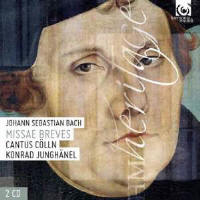Texte paru dans: / Appeared in: |
|
|
Outil de traduction (Très approximatif) |
|
|
Reviewer:
Jonathan Freeman-Attwood Animated and often virtuosic but questions abound over the approach... The four "short" Masses (only the Kyrie and Gloria texts are set) have been slow to become established on record, though they are emerging as interesting parody alternatives to their cantata originals. The rationale for Bach to start collating such pieces probably derives from wanting to leave a legacy of pieces in all the genres in which he worked. Practical considerations could also have played a part: the ordinary of the Mass is rather more perennially useful than cantatas, whose texts are wedded to the church calendar. Cantus Cölln expand the one-to-a-part aesthetic here with the fortification of an extra part. With their notable blend, the vocal group sit gently within a resonant instrumental ensemble whose elegance is best heard in the fruity F major Mass (BWV233) and the A major's (BWV234) lightly dabbed flute articulations which present the work in a decidedly Enlightenment hue. The arched and antiquated polyphony of the G major Mass (BWV236) receives less of the smooth and glowing radiance which marks out Philippe Herreweghe's reading (Virgin) but there is an alertness to declamatory possibility and textural coloration here which, other than in some surprising blips in tonal focus, contributes to a dynamic performance overall. As in Junghanel's recording of the B minor Mass, the ensemble ethos takes precedence over variety of individual expression and so, despite consistently good singing from the bass soloist, the solo "arias" or sections are generally the least successful. I admire much of the energy, verve and the sheer level of execution but the Cantus Cölln "democratic" approach can become a fairly mono-dimensional experience. |
|
|
Sélectionnez votre pays et votre devise en
accédant au site |
|
|
|
|
|
Cliquez l'un ou l'autre
bouton pour découvrir bien d'autres critiques de CD |
|



